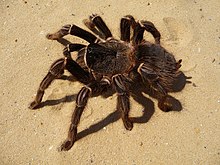Lasiodora parahybana
| Brazilian salmon pink bird-eating tarantula | |
|---|---|
 |
|
| Scientific classification | |
| Kingdom: | Animalia |
| Phylum: | Arthropoda |
| Class: | Arachnida |
| Order: | Araneae |
| Suborder: | Mygalomorphae |
| Family: | Theraphosidae |
| Genus: | Lasiodora |
| Species: | L. parahybana |
| Binomial name | |
|
Lasiodora parahybana (Mello-Leitão, 1917) |
|
Lasiodora parahybana, the Brazilian salmon pink bird-eating tarantula, also simply known as the salmon pink or LP, is a relatively large tarantula from north-eastern Brazil. L. parahybana is considered to be the third largest tarantula in the world (behind Theraphosa blondi and Theraphosa apophysis; however, the largest spider is the giant huntsman spider in terms of leg-span).
It was discovered and described in 1917 by Cândido Firmino de Mello-Leitão, in Paraíba, where the tarantula is endemic. They are popular pets in the tarantula hobby due to their large size and readiness to breed.
The salmon pink bird-eater can attain a leg size of up to 11 inches; especially in males as their legs are longer than the female’s. However, females can weigh more than 100 grams. Females are often ‘bulky;’ they have a large body size in comparison to their legs. Males tend to be slender in body size. This is sexual dimorphism. Mature males will also have tibial hooks on the front pair of legs; these hook back a female’s fangs during mating.
They are considered a ‘pretty’ tarantula species; they are a uniform black colour, and once mature, have pink-red hairs along the legs, chelicerae and abdomen; in males, the colour tends to be more vibrant. Black or brown hair covers the rest of the tarantula.
L. parahybana are endemic to Brazil in the Atlantic forest region of the country; they are known from one area near Campina Grande.
When threatened, the tarantula will raise its legs in the air, as well as the front of its body, in order to deter predators. If the attacker continues to attack, the tarantula will bite. The Brazilian salmon pink tarantula is capable of delivering a painful bite. They are known to bite only when provoked, and even then, this is a last resort. Bites from an L. parahybana are mechanically dangerous; fangs can be up to an inch long. Some sites claim that a bite from a salmon pink is similar to that of a cat. However, rather than biting, they choose to flick urticating hairs from a patch on their abdomen; these hairs are covered in barbs which irritate the skin and put off potential predators. These hairs are extremely irritating; in the hobby, they are considered to be one of the more painful hair types. If the hairs are thrown into the eyes, blindness can occur.
...
Wikipedia
